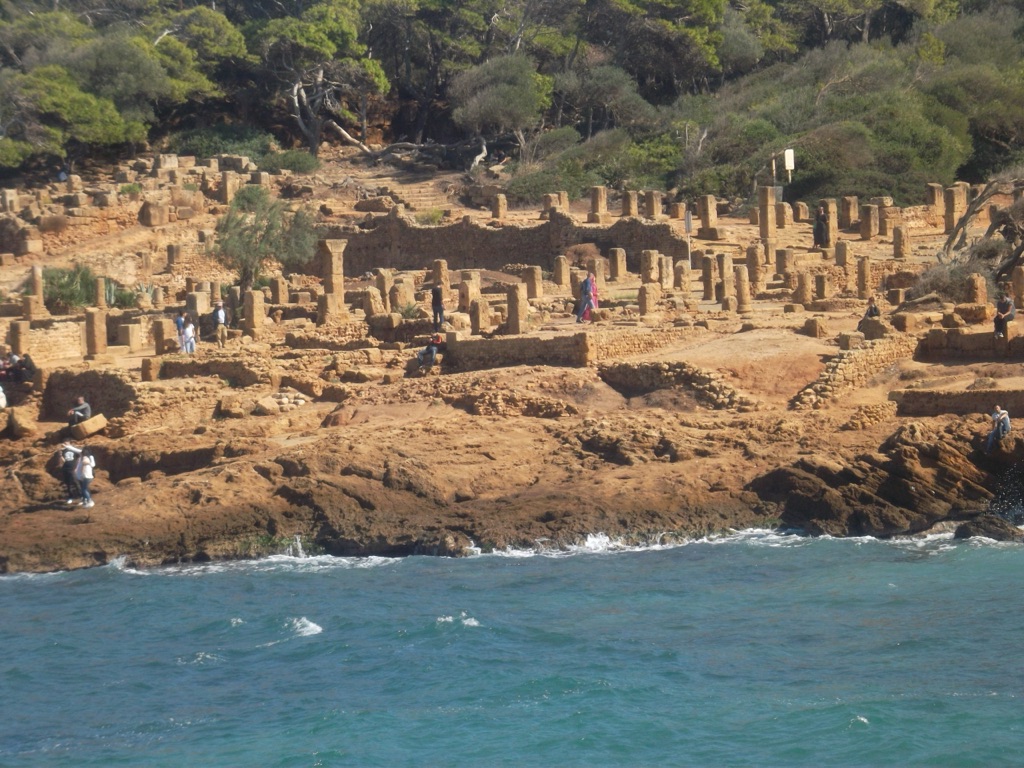Tipasa is a historical site located on the coast of the Mediterranean Sea. It was once an ancient Punic trading post before becoming a Roman military colony. Over time, it evolved into a significant Christian center during the Byzantine era. The ruins of Tipasa encompass a unique blend of Phoenician, Roman, early Christian, and Byzantine cultures, making it a valuable archaeological site. Its remains include a forum, basilicas, temples, and an amphitheater, reflecting its diverse historical influences. UNESCO has recognized Tipasa as a World Heritage Site, highlighting its importance.
Get your dose of History via Email
Historical Background of Tipasa
Tipasa, nestled on the Algerian coast, was originally a Carthaginian trading post. The Romans later established it as a strategic military colony. Its discovery by modern archaeologists dates back to the 19th century. European scholars took an interest in its unique blend of ruins. The site was built and inhabited by various civilizations, including the Phoenicians, Romans, and Byzantines. Each left their mark on the city’s architecture and culture.
The Romans, under Emperor Claudius, recognized the strategic importance of Tipasa. They expanded it into a full-fledged colony around the 1st century AD. The city thrived under Roman rule, as evidenced by the extensive ruins. These include a forum, theater, and aqueducts. Tipasa became a Christian stronghold during the Byzantine Empire. This period saw the construction of several basilicas.
Later, the city fell to the Vandals and then the Byzantines before the arrival of the Arabs. Each era contributed to the city’s rich tapestry of history. The site was not only a bustling urban center but also a witness to several historical events. These include the spread of Christianity in North Africa and the Byzantine reconquest.
The ruins of Tipasa were rediscovered and excavated in the 19th century. French military officers stationed in Algeria were among the first to take an interest. Since then, numerous archaeological missions have uncovered its layered history. The site’s significance lies not only in its historical value but also in its cultural impact. It has contributed to our understanding of Roman urban planning and early Christian architecture.
Today, Tipasa stands as a testament to the region’s complex past. It attracts scholars and tourists alike. Its historical importance is underscored by the fact that it was the scene of key developments. These include the spread of various religions and cultures across the Mediterranean.
About Tipasa
Tipasa’s ruins paint a picture of its grandeur during Roman times. The city’s layout follows a typical Roman grid pattern. It includes a forum, which served as a public square and marketplace. The remains of an ancient theater suggest a rich cultural life. The city also boasted residential quarters, baths, and an aqueduct system, showcasing advanced Roman engineering.
The construction techniques and materials used in Tipasa varied according to the period. The Phoenicians utilized local stone, while the Romans introduced brick and concrete. The Romans also brought their architectural styles, as seen in the remains of the basilicas and temples. These structures often featured columns, arches, and intricate mosaics.
One of the most notable architectural highlights of Tipasa is the basilica. It was a place of Christian worship and community gathering. The basilicas’ designs reflect the transition from pagan Roman architecture to Christian religious structures. The use of space and light in these buildings was innovative for the time.
The amphitheater of Tipasa, though smaller than those found in larger Roman cities, indicates the presence of entertainment and social gatherings. The city’s necropolis, with its elaborate tombstones and mausoleums, provides insight into the beliefs and customs surrounding death and the afterlife.
Overall, the architectural remains of Tipasa are a rich source of information. They tell us about the daily lives and practices of its ancient inhabitants. The site’s preservation allows for ongoing study and appreciation of its historical significance.
Theories and Interpretations
Several theories exist about the use and significance of Tipasa in antiquity. Some scholars suggest that its strategic location made it a vital trade hub. Others believe it played a key role in the military strategy of the Roman Empire. The presence of Christian basilicas points to its importance as a religious center.
Mysteries still surround Tipasa, particularly regarding the extent of its urban sprawl and the full range of its inhabitants’ activities. Archaeologists have had to interpret the site’s layout and artifacts to piece together its history. They often match these findings to historical records from the era.
Dating the various structures and layers of Tipasa has been a significant focus of research. Archaeologists have employed methods such as stratigraphy and radiocarbon dating. These techniques help establish a timeline for the city’s development and decline.
Theories about the city’s decline are also a subject of debate. Some attribute it to the fall of the Roman Empire. Others point to natural disasters or invasions as possible causes. The exact reasons remain a topic of scholarly investigation.
Despite these uncertainties, the consensus is that Tipasa was a melting pot of cultures. It was a place where Punic, Roman, and Christian influences intersected. This has made the site a rich field for academic study and interpretation.
At a glance
Country: Algeria
Civilization: Phoenician, Roman, Byzantine
Age: Founded in the 5th century BC, Roman colony established in the 1st century AD
Conclusion and Sources
The information in this article about Tipasa has been sourced from reputable and authoritative references. These include:
– UNESCO World Heritage Centre: https://whc.unesco.org/en/list/193
– Encyclopaedia Britannica: https://www.britannica.com/place/Tipasa

